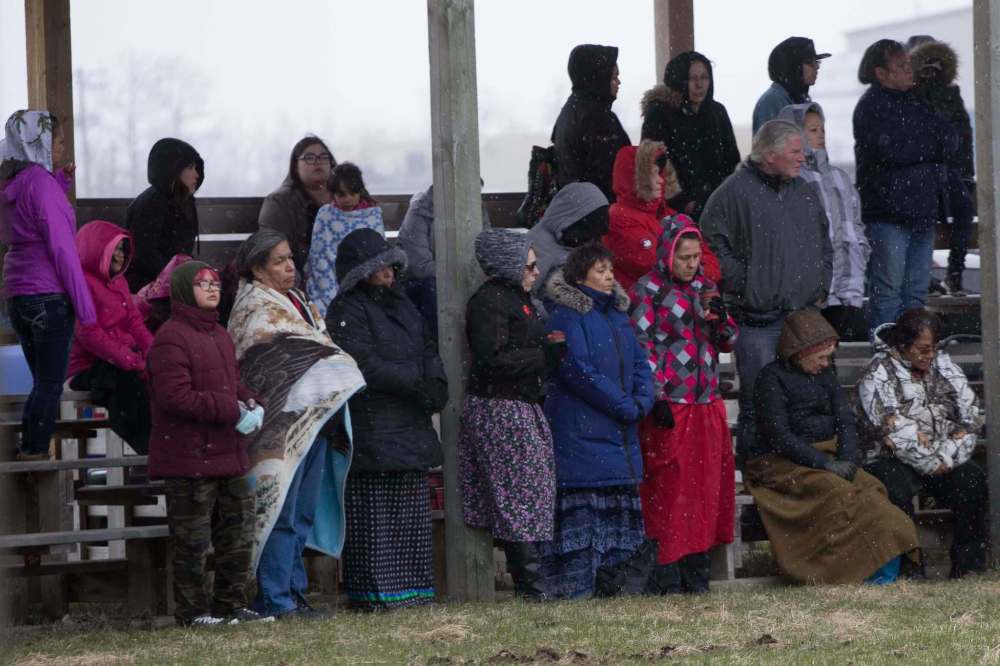‘It stirred the community’
Sagkeeng offered support in aftermath of teen's slaying
Advertisement
Read this article for free:
or
Already have an account? Log in here »
To continue reading, please subscribe:
Monthly Digital Subscription
$0 for the first 4 weeks*
- Enjoy unlimited reading on winnipegfreepress.com
- Read the E-Edition, our digital replica newspaper
- Access News Break, our award-winning app
- Play interactive puzzles
*No charge for 4 weeks then price increases to the regular rate of $19.00 plus GST every four weeks. Offer available to new and qualified returning subscribers only. Cancel any time.
Monthly Digital Subscription
$4.75/week*
- Enjoy unlimited reading on winnipegfreepress.com
- Read the E-Edition, our digital replica newspaper
- Access News Break, our award-winning app
- Play interactive puzzles
*Billed as $19 plus GST every four weeks. Cancel any time.
To continue reading, please subscribe:
Add Free Press access to your Brandon Sun subscription for only an additional
$1 for the first 4 weeks*
*Your next subscription payment will increase by $1.00 and you will be charged $16.99 plus GST for four weeks. After four weeks, your payment will increase to $23.99 plus GST every four weeks.
Read unlimited articles for free today:
or
Already have an account? Log in here »
Hey there, time traveller!
This article was published 28/04/2017 (3154 days ago), so information in it may no longer be current.
A Manitoba First Nation is receiving offers of increased counselling services in the wake of a tragedy that has attracted international attention and spurred the small community to take action.
Sagkeeng First Nation Chief Derrick Henderson said Friday he appreciates Health Canada’s offer to help and for extra support from counselling services in Ontario.
The community of about 3,350 was shocked by the beating death of 19-year-old Serena McKay, leaving the local crisis team “overburdened” as counsellors remain in the high school to help students and teachers who knew the victim and the two teenage girls accused in her death.

The two girls, aged 16 and 17, were charged with second-degree murder for the April 22 incident. A video of the beating was posted on Facebook. McKay’s body was found Sunday by a resident.
The motive for the beating remains unclear as police continue to investigate. In the meantime, some in Sagkeeng hope McKay’s death can become a symbol of change, to make sure such a tragedy never happens again.
“It stirred the community, and I’m glad it did. I know what the issues are,” the chief said, speaking of the gang involvement, substance abuse and prescription drug addiction that has afflicted the community in recent years.
“As a community, we have to be the ones. We can’t rely on somebody outside Sagkeeng to come and help us. We have all the answers inside our community. Every house, every community member has a responsibility for their neighbour, their children, their siblings.
“If we don’t start making changes in the community, we’ll be in this circle again in a month or two. Is that what we want as a community? So it’s all about intervention, prevention, doing something to make it better. And that’s the message that was given” at a vigil for McKay Thursday, and it’s the message that will be repeated during consultations with local leadership and band members, Henderson said.

As the community prepares for McKay’s funeral Monday, Henderson said, people are asking what they can do next to move forward.
Those questions are important, says Alan Leschied, a psychologist and professor at the University of Western Ontario who has been researching youth justice and children’s mental health for the past 40 years.
In the past 15 years, he’s seen the rate of violence among girls nearly double. While boys are still the perpetrators of violence in an overwhelming majority of cases, studies show girls are increasingly acting out violently — usually toward other girls, Leschied said.
“Girls who commit violence tend to have many more mental health issues going on with them relative to boys. Girls who are violent tend to have past histories of depression, past histories of suicidal ideation and also are more likely to have been victimized themselves in some way, either through sexual violence or physical violence,” he said.
It’s important for society to see where the violence stems from in order to stop it, he said, adding that violent behaviour is often passed down through generations.

“I don’t want to treat such a tragic death as a symptom, but the reason this is so important is it’s a symptom of something that underlies what’s going on within a community, that something like this (was) allowed to escalate to this point. After a death, you need to go in and look at what were the conditions, what were the contributors to why this occurred, what are the things that we can learn from this, and what do we need to do differently?” he said.
katie.may@freepress.mb.ca Twitter: @thatkatiemay

Katie May is a general-assignment reporter for the Free Press.
Our newsroom depends on a growing audience of readers to power our journalism. If you are not a paid reader, please consider becoming a subscriber.
Our newsroom depends on its audience of readers to power our journalism. Thank you for your support.
History
Updated on Saturday, April 29, 2017 8:13 AM CDT: Headline changed, comments off.


